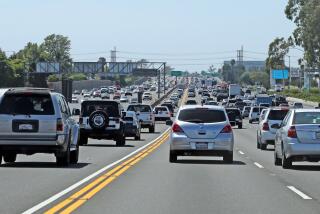Senate Rejects Bid to Retain 55-M.P.H. Cap
- Share via
WASHINGTON — The Senate rejected an effort to retain the 55-m.p.h. national speed limit for cars and light trucks Tuesday as it considered legislation that would give authority to regulate highway speed back to the states.
Fifty Republicans and 15 Democrats voted against keeping the federal limits of 55 m.p.h. in urban areas and 65 m.p.h. in rural areas. Four Republicans and 31 Democrats, including California Sens. Dianne Feinstein and Barbara Boxer, voted to restore the limits to the legislation. The limits are a legacy of the energy crises of two decades ago.
The Senate narrowly voted to continue the existing federal speed limit for large trucks and buses. But it narrowly defeated a GOP proposal to grant states a free rein in deciding whether to require the use of seat belts and motorcycle helmets.
Arguing for ending the speed limits for cars and light trucks, Sen. Lauch Faircloth (R-N.C.) said that it is “simple common sense” to turn the matter over to the states. The 1974 speed-limit law was “the worst example of the ‘Washington knows best’ ” mind-set and a federal intrusion that must end, he said.
Opponents warned that repealing the speed limit would lead to more traffic injuries and fatalities.
“We know what the results are going to be” if the law is repealed, said Sen. Mike DeWine (R-Ohio). “More people will die on our highways.”
DeWine joined Sens. Frank R. Lautenberg (D-N.J.) and Feinstein (D-Calif.) in the effort to restore federal speed limits to the legislation.
Transportation Secretary Federico Pena said he was disappointed by the Senate vote, saying that “repeal of the national maximum speed-limit law would result in nearly 5,000 lives lost every year.”
The debate over speed limits, seat belts and helmets occurred during Senate consideration of the National Highway System bill, which would provide $13 billion over two years to improve 160,000 miles of heavily used roads across the United States.
Senate passage of the legislation could come as early as today, although the Senate is scheduled to interrupt the debate to take up the controversial nomination of Dr. Henry W. Foster Jr. to be U.S. surgeon general. The House has yet to consider a highway bill.
Federal law dictates a 55-m.p.h. speed limit on most interstate highways and a cap of as much as 65 m.p.h. in rural areas. States that do not comply are denied certain federal highway maintenance and construction funds.
The Senate voted, 51 to 49, to keep the 55/65 speed limit for large freight-hauling trucks that weigh more than 26,000 pounds and for commercial buses that carry more than 16 passengers.
Sen. Harry Reid (D-Nev.), who pressed to continue the speed limit for trucks, said he realized on a recent trip home that “we were doing the wrong thing by lifting the speed limit for all vehicles.” Trucks go fast trying to meet deadlines carrying huge loads, he said, and “by slowing these trucks down we’re going to have less fatalities.”
Late in the day, the Senate killed, 52 to 45, an amendment by Sen. Robert C. Smith (R-N.H.) that would have stopped Washington from denying highway construction and maintenance funds to states that do not require the use of seat belts and helmets.
California enacted a mandatory seat belt law in 1991 and passed a law requiring motorcyclists to wear helmets in 1992.
Congress enacted the national speed limits law after the 1973 energy crisis. But critics said that the statute has become archaic because cars today are far more fuel-efficient and much safer because of air bags, anti-lock brakes and anti-drunk driving laws.
In 1987, Congress amended the law to allow states to increase speed limits to as much as 65 m.p.h. on rural stretches of highway. But that led to more speed-related deaths, according to Lautenberg. He said that there were 55,000 motor vehicle-related fatalities in 1973, the year before the speed limits law was adopted. Today, there are about 40,000 such fatalities annually, with about 10,000 of them speed-related, Lautenberg said.
More to Read
Sign up for Essential California
The most important California stories and recommendations in your inbox every morning.
You may occasionally receive promotional content from the Los Angeles Times.









